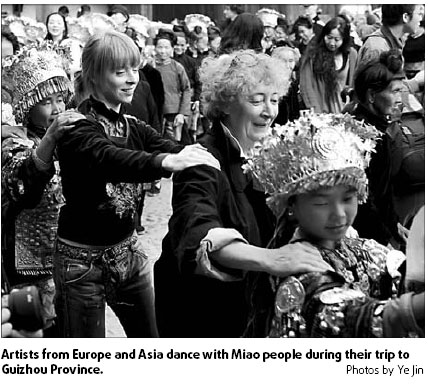The clock was ticking. Only two days before their show, an international troupe of performing artists had no idea what would happen on the stage. Eighteen choreographers and musicians from 13 countries across Asia and Europe spent five days visiting remote villages of the Miao minority in Southwest China's Guizhou Province to gather material and inspiration.
The group returned to Beijing and spent four days intensely workshopping the "Pointe to Point" Asia-Europe Dance Forum production.
Some artists had different opinions during rehearsals and quarreled accordingly. However, like many creative events, the show came together at the theater of China Art Academy in Beijing and it was a very special performance.
"It's a short time, and we did our best," says Belgian guitarist Emmanuel Baily, one of the players in the project.
"All of our experiences in these 12 days - drinking in the Miao villages, traveling in buses and talking with artists of different cultural backgrounds - have influenced our creation."
Organized by the Asia-Europe Foundation and China Dancers Association, the fifth "Pointe to Point" project started in Beijing on November 13, and participants traveled to Guizhou and visited Miao villages in Leishan, Taijiang and Jianhe counties.
The artists enjoyed the Miao people's music and dance. In Xijiang Village of Leishan, they celebrated the Miao New Year with locals, and some artists participated in local activities, such as making sticky rice cakes.
"This trip will always be in my memory," says Indonesian choreographer Hartati.
"At a time of globalization, it is a really interesting experience to see the culture and life of the Miao people."
At the same time, the artists also observed the changes of Miao people's lives brought by tourism and modernization.
"We saw the contrast between traditional Miao houses and newly built hotels," says Ula Sickle, a choreographer from Poland.
"Do the Miao people enjoy the changes? What will happen to them in 10 years? As artists we have to speak to people's living situations."
Obviously, the final presentation was very much related to the trip to Guizhou.
Before the performance started, the artists distributed oranges to the audiences in the lobby, in a way like the hospitable Miao people welcoming guests in their villages.
The presentation was divided into three parts, each created by a sub-group of choreographers and musicians. All the sub-groups invited other artists to join at some point.
"Each sub-group is like a family, and together they form a village," says Korean choreographer Kim Seong Hee, who is an artistic observer of the project.
"Each family keeps their individuality, but they are all open to sharing with and learning from others."
The first part of the presentation took place off stage, as dancers and musicians performed throughout the theater and interacted with the curious audience.
In the second part, Malaysian choreographer Mei Yin Ng was dressed in a net and adorned with metal spoons and forks, which jingled like the silver decorations on Miao women's clothes.
Through a series of abstract movements, the second part seemed to probe the destiny of tradition in modern time.
In the third part, dancers walked quickly in circles, creating dynamic and collective movements.
"After staying in Beijing and Miao villages, we found that Miao people were connected by dancing, while in the city, people are connected by fast walking," says choreographer Arco Renz from Germany.
"In this work we are trying to combine our experiences in the urban and rural situations."
Urbanism versus ruralism is one of the focuses of this year's "Pointe to Point" project. Other concerns include Asia versus Europe, dance versus music and tradition versus modernity.
"Pointe to Point" was initiated in 2002, aiming to empower aspiring young artists from Asia and Europe to reflect upon their views of contemporary society through their individual artistic expressions.
It aims to provide young people with a process-oriented platform for artistic exchange and dialogue through the arts. Since 2002, "Pointe to Point" has been taking place alternatively in Asia and Europe.
"What's most important in this project is not the final presentation, but the process of exchanging, collaborating, and understanding each other's cultural backgrounds," says Katelijn Verstraete, project manager of the Cultural Exchange Department of Asia-Europe Foundation.
Three Chinese artists participated this year's project: choreographers Wang Mei and Shi Jingxin, and guqin (seven-stringed Chinese zither) player Wu Na.
"Working with other artists in this project has greatly expanded my vision as a choreographer and has made me ponder more questions than before," says Shi, who is in charge of some of the choreography of the opening ceremony of the 2008 Beijing Olympics.
"All of us have some limits, and we tried to break those limits to understand each other," says Belgian guitarist Baily, who improvised with Wu on guqin, Benoit Gazzal from France on double bass, Tomoko Momiyama from Japan on accordion and Artur Vidal from Spain on saxophone.
All the participants believed that the presentation was not a finished work but rather a sum-up of their exchange and thinking during the project.
"The trip to Guizhou inspires me to go back to my roots and do some work to preserve my culture," says Jethro Pioquinto, a choreographer from the Philippines.
"A contemporary artist should know and treasure the tradition. I hope in the future I will be not only an artist, but also a cultural worker."
Malaysian choreographer Ng says she has learned a lot from the project, but now she has more questions.
"How should we preserve the tradition? Do we have the right to ask minority people to preserve their tradition? I have to go back with these questions," says she. "For me, 'Pointe to Point' is not a finishing point, but a starting point."
The sixth Pointe to Point will take place next year in Portugal, in collaboration with the Alkantara Festival in Lisbon.
(China Daily November 27, 2007)




